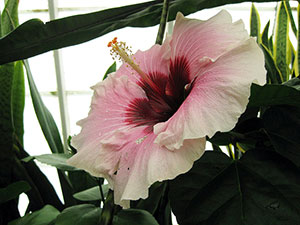Hibiscus
Hibiscus is a flowering shrub that evokes an image of a vivid tropical paradise, with flowers that come in a rainbow of colors.

Tropical hibiscus (Hibiscus rosa-sinensis) is what’s commonly seen in garden centers and landscapes. It is thought to have originated in tropical of Asia.
Hibiscus flowers can be many colors, come in single or double forms, and often last for just a day. Individual flowers may be short-lived, but the plant will produce blooms over a long flowering season—nearly year-round in South Florida. Hummingbirds are attracted by hibiscus; many types of butterflies are as well, including Cloudless Sulfurs, blues, and Gulf Fritillaries.
Hibiscus range in size from low spreading shrubs to upright tree forms that can reach twenty feet in height. Some are compact and dense, while others are open and thin. They are used in the landscape as informal hedges or screens, foundation plants, specimens, or background for other plants.
In the South, they’ll stay green throughout the year, while in North Florida hibiscus will freeze to the ground, but usually return from the roots. Tropical hibiscus are sensitive to cold weather; the slightest cold wave can cause lower leaves to yellow and drop off.
Native Hibiscus

There are about 35 species of native hibiscus, also called rosemallows, in the United States. Their flower colors range from white to pink to yellow to red, and their common names are often interchanged (learn more about confusing common names for plants here).
One hibiscus native to Florida, Hibiscus coccineus, is also known as the scarlet rosemallow, marsh hibiscus, or swamp mallow. This upright herbaceous perennial can reach a height of 4 to 8 feet. The long leaves of the marsh hibiscus have slender lobes with jagged teeth. Large, gorgeous deep-red flowers appear in mid- to late summer.
The marsh hibiscus is often used as a specimen plant in the landscape but may go dormant in the winter. It can also be used around ponds or streams. But while the marsh hibiscus is native to wetland areas—which is where its common name comes from—it is tolerant of somewhat drier soils. This hibiscus requires full sun or partial shade. It can be propagated by seed or division.
Pests and Mites
Scout your hibiscus regularly for pests such as aphids, whiteflies and mealybugs. These piercing sucking insects are usually found in clusters on leaves and flower buds. Scout by flipping leaves and looking for the pests or by noticing sooty mold growing on the honey dew produced. If caught early they are easily controlled with insecticidal soaps or horticulture oils. Be sure to read labels carefully— you should never use the pesticide malathion on hibiscus.
